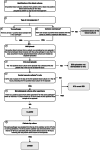Surveillance of catheter-associated bloodstream infections: development and validation of a fully automated algorithm
- PMID: 38600526
- PMCID: PMC11007875
- DOI: 10.1186/s13756-024-01395-4
Surveillance of catheter-associated bloodstream infections: development and validation of a fully automated algorithm
Abstract
Background: Most surveillance systems for catheter-related bloodstream infections (CRBSI) and central line-associated bloodstream infections (CLABSI) are based on manual chart review. Our objective was to validate a fully automated algorithm for CRBSI and CLABSI surveillance in intensive care units (ICU).
Methods: We developed a fully automated algorithm to detect CRBSI, CLABSI and ICU-onset bloodstream infections (ICU-BSI) in patients admitted to the ICU of a tertiary care hospital in Switzerland. The parameters included in the algorithm were based on a recently performed systematic review. Structured data on demographics, administrative data, central vascular catheter and microbiological results (blood cultures and other clinical cultures) obtained from the hospital's data warehouse were processed by the algorithm. Validation for CRBSI was performed by comparing results with prospective manual BSI surveillance data over a 6-year period. CLABSI were retrospectively assessed over a 2-year period.
Results: From January 2016 to December 2021, 854 positive blood cultures were identified in 346 ICU patients. The median age was 61.7 years [IQR 50-70]; 205 (24%) positive samples were collected from female patients. The algorithm detected 5 CRBSI, 109 CLABSI and 280 ICU-BSI. The overall CRBSI and CLABSI incidence rates determined by automated surveillance for the period 2016 to 2021 were 0.18/1000 catheter-days (95% CI 0.06-0.41) and 3.86/1000 catheter days (95% CI: 3.17-4.65). The sensitivity, specificity, positive predictive and negative predictive values of the algorithm for CRBSI, were 83% (95% CI 43.7-96.9), 100% (95% CI 99.5-100), 100% (95% CI 56.5-100), and 99.9% (95% CI 99.2-100), respectively. One CRBSI was misclassified as an ICU-BSI by the algorithm because the same bacterium was identified in the blood culture and in a lower respiratory tract specimen. Manual review of CLABSI from January 2020 to December 2021 (n = 51) did not identify any errors in the algorithm.
Conclusions: A fully automated algorithm for CRBSI and CLABSI detection in critically-ill patients using only structured data provided valid results. The next step will be to assess the feasibility and external validity of implementing it in several hospitals with different electronic health record systems.
Keywords: Bloodstream infection; CLABSI; Catheter-infection; Digital; Healthcare associated infections; Intensive care unit; Internal validation; Sensitivity; Specificity.
© 2024. The Author(s).
Conflict of interest statement
All authors have no conflicts of interest to declare.
Figures

References
-
- Cassini A, Plachouras D, Eckmanns T, Abu Sin M, Blank HP, Ducomble T, et al. Burden of six healthcare-associated infections on European population health: estimating incidence-based disability-adjusted life years through a population prevalence-based modelling study. PLoS Med. 2016;13(10):e1002150. doi: 10.1371/journal.pmed.1002150. - DOI - PMC - PubMed
-
- Suetens C, Latour K, Kärki T, Ricchizzi E, Kinross P, Moro ML, et al. Prevalence of healthcare-associated infections, estimated incidence and composite antimicrobial resistance index in acute care hospitals and long-term care facilities: results from two European point prevalence surveys, 2016 to 2017. Euro Surveill. 2018;23(46):1800516. doi: 10.2807/1560-7917.ES.2018.23.46.1800516. - DOI - PMC - PubMed
-
- Healthcare-associated infections in intensive care units - Annual Epidemiological Report for 2017. 2019. https://www.ecdc.europa.eu/en/publications-data/healthcare-associated-in.... Cited 2023 Apr 5.
-
- Tabah A, Buetti N, Staiquly Q, Ruckly S, Akova M, Aslan AT, et al. Epidemiology and outcomes of hospital-acquired bloodstream infections in intensive care unit patients: the EUROBACT-2 international cohort study. Intensive Care Med. 2023;49(2):178–90. doi: 10.1007/s00134-022-06944-2. - DOI - PMC - PubMed
MeSH terms
LinkOut - more resources
Full Text Sources
Medical

